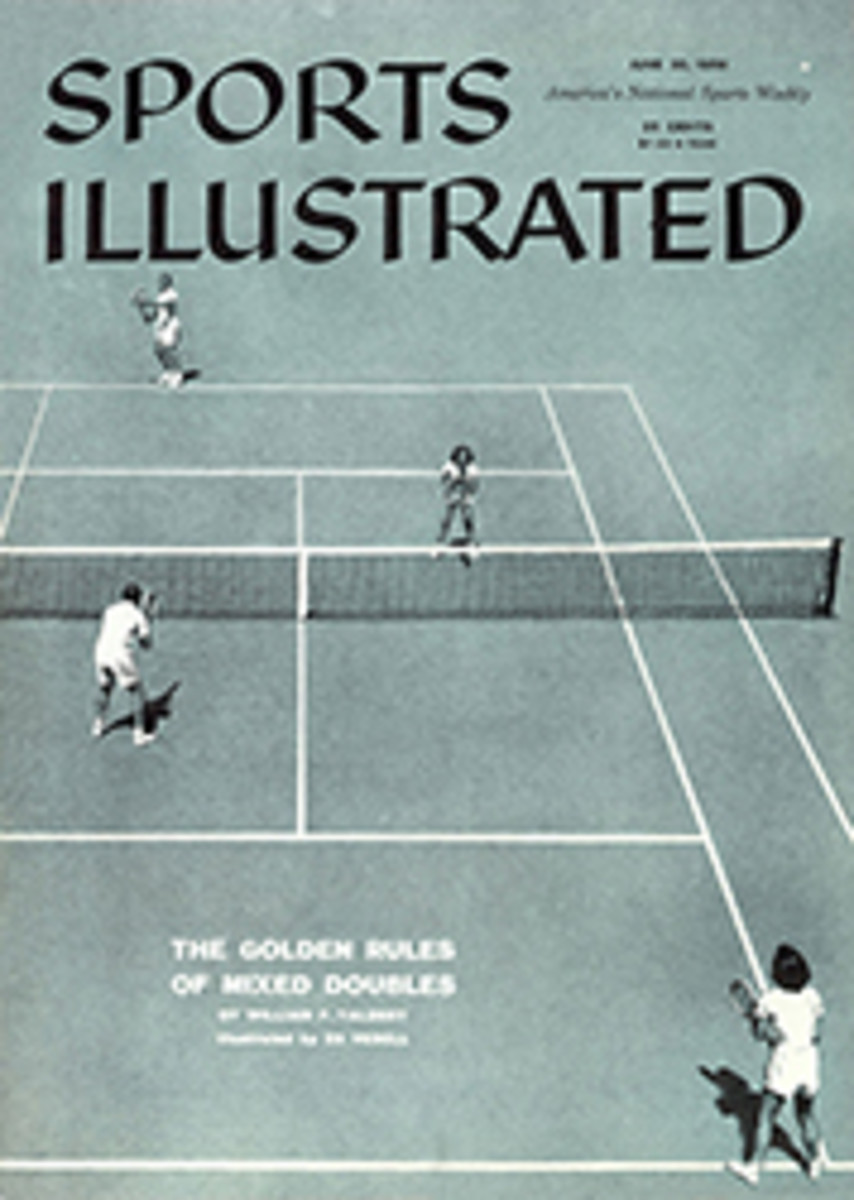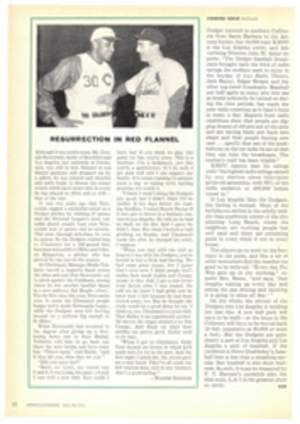
MITCHELL MAKES HISTORY
Sports Illustrated's boating editor who was aboard the class A competitor Dyna, arrived in Bermuda shortly before Finisterre to record his own evaluation of the race.
When Carleton Mitchell won the Bermuda Race for the second time in a row with his 38-foot 8-inch yawl Finisterre, he scored the most resounding triumph in the modern history of the race. Not only is he the first man to win this most demanding of all blue-water events twice in succession, but he also has the satisfaction of proving for all time two things which a number of skeptics felt were only half proved by his initial Bermuda victory.
First, he demonstrated that he can win under any conditions against the crack racers of the northeastern fleet, as well as in the Southern Circuit and the Chesapeake, where he made his early reputation.
Second, and more important than any racing victory, he proved the superiority of his ideas of boat design—namely, that a fat, shallow, short-rigged little cruising boat can, under the rating rules of the Cruising Club of America, beat the tallest, slimmest, most powerful racing machines in the Atlantic fleet.
Finisterre's dimensions are, according to all nautical traditions, preposterous for a boat that is going to race against the trim greyhounds of the sea, with their towering rigs and 9-foot keels. Mitchell's yawl, whose lines were drawn up by Sparkman & Stephens, has a draft only 3 feet 11 inches with the centerboard up, and 7 feet 6 inches with the board down. Her water line, the best index to a boat's potential speed, measures only 27 feet 6 inches. Her beam, drawn strictly for comfort, is a tubby 11 feet 3 inches. She is, in fact, the most extreme example of a type of family boat whose speed is theoretically so hampered by obesity that she is given the most generous of handicaps. And yet she demolished the competition, winning 18 of 30 races through June of 1956. Her success, and that of such distinguished ancestors as Ayesha, Escapade, Caribbee and Marie Amelie, started a revolution in the design of ocean racers. The slim, statuesque racing queens went out of vogue, and suddenly a lot of people started loving the fat girl.
This was just fine with designers like Philip L. Rhodes, who was one of the pioneers of the class, and with Sparkman & Stephens, which turned itself into a centerboard factory, cranking out Finisterre imitators at such a rate that when the fleet went to the line last week for the 1958 Bermuda Race, you could hardly find Finisterre for her sisters and stepsisters.
However, the success of Finisterre, her design and her skipper, was not so fine with some of the competition. They complained that her rating was too low, and that the recent changes in the Cruising Club Rule (SI, June 16) had not raised it enough. They said, truthfully, that the Bermuda Race is a crap shoot. And they said, hopefully, that Mitchell was lucky last time, that he couldn't possibly do it again—not with a record field of 111 boats. In any event, they were sure Mitchell had won in 1956 in his weather—a hard, steady blow that could keep the fat little boat moving.
Then the 1958 race went off. And it went off in nobody's weather. It started with a 28-to 38-knot northwesterly blowing from aft. In two hours it had dropped to a zephyr, then came in fresh from the southwest, meandered around the westerly quadrant for three days and finally died to one of the most infuriating calms in the history of the race. The leaders wallowed in an agonizing vacuum, sails slatting back and forth in the lumpy sea.
Finally, on the last day, the wind came. It came in from dead ahead, and it came in dead earnest. Line squalls roared in from a darkening horizon, spitting rain and tearing a gray veil of spume from the surface of the ocean. By noon on that last day many of the big boats, like Jack Hedden's Good News and Clayton Ewing's Dyna, had tucked in reefs and were carrying small, heavy-weather jibs. But as the afternoon wore on the wind blew harder. It blew the headsails off a lot of ocean racers. It came near blowing the metal tracks that hold the jib sheet leads off the Navy's big yawl Royono.
And it blew Finisterre right down to the finish at St. David's Head, so fast and so far ahead of Mitchell's handicap that from the moment he crossed the line, there was virtually no doubt he was the winner for the second time in a row. There was also no doubt now that Mitchell and his fat little lady friend were the most distinguished couple in the world of ocean racing. The most gallant, perhaps, was Jack Hedden and Good News. Only five months ago Hedden was fished from the water when his old boat Celebes burned to the water line halfway through the Acapulco Race (SI, Feb. 3). On April 1 Hedden bought Good News, and in this, his first major race in the new boat, he was first to cross the line at St. David's Head, first to finish in the 1958 Bermuda Race. The victory, however, belonged to Finisterre, and there no longer could be any sensible criticism of the victory or of the boat or of the skipper. "Mitch," said one Bermuda veteran congratulating the winner, "when you win the Bermuda Race once, it can be luck. But when you win it twice, it's got to be something else."
MAP
1958 BERMUDA RACE CHART
NEWPORT
START
BRENTON REEF LIGHTSHIP
NOON JUNE 15
635 MILES TO BERMUDA
RHUMB LINE
OCEAN
GULF STREAM CURRENT
ATLANTIC
NOON JUNE 16
NOON JUNE 17
NOON JUNE 18
FINISH
ST. DAVID'S HEAD
BERMUDA
[Reddots]FINISTERRE
[Blackhyphens]X GOOD NEWS
[BlackHyphendot]O DYNA
PHOTO
WINNER Carleton Mitchell (left) is presented with the Bermuda trophy for over-all corrected-time victory by Lieut. General Sir John Woodall, the governor of Bermuda.
PHOTO
WESTERNER Jack Hedden (at wheel) sailed lucky, skippered first finisher Good News. In the Acapulco Race last February, Hedden sailed unlucky, lost his Celebes in a fire. Seated (from left) are Crewmen James Wilhite, Bill Lawhorn, Myron Spaulding, Derek Baylis, Dick Terkel. Standing are Charles Ayres, Warwick Tompkins Jr.
PHOTO
SAILMAKER Colin Ratsey (center, dark shirt) took time from sewing sails for America's Cup defenders, came in second over-all with his 40-foot yawl Golliwogg after hours of tactical dueling with winner Mitchell. Other crewmen are Robert Erskine, Joseph Walden, Vincent Montesano, Arthur Wullschleger and Philip Snyder.
ILLUSTRATION
ILLUSTRATION
1
2
3
4
5
6
7
8
9
10
11
12
13
14
15
16
17
18
19
20
21
22
23
24
25
26
27
28
29
30
31
32
33
34
35
'FINISTERRE': WINNINGEST OCEAN RACER IN THE WORLD
A second look at Finisterre's inside (this magazine's readers got their first look in June 1956) shows Finisterre as the perfect combination of speed and comfort at sea, able to cruise an ocean safely and outrace anything its size.
LENGTH: 38'8"
BEAM: 11'3"
MAST: 49'9½"
RIG: YAWL
1 After pulpit
2 Mizzen
3 Clutch
4 Wheel
5 Binnacle
6 Movable backrests
7 Condiment containers
8 Companionway
9 Glass rack
10 All-wave radio
11 Translucent-bottom dinghy
12 Skylight
13 Kerosene gimbal lamp
14 Main-cabin ventilator
15 Mainmast
16 Forward hatchcover
17 Forward ventilator
18 Forward pulpit
19 Forepeak
20 Stowage space
21 Forward head
22 Folding sink
23 Mainmast step of sheet Monel
24 Doorway to main head
25 Removable pipe berths for additional crew
26 Lead ballast in keel weighs 5,660 pounds
27 527-lb. bronze centerboard adds 3'7" to draft
28 Centerboard winch and handle
29 Garbage pail recessed in centerboard trunk
30 32-hp gasoline engine
31 Automatic pilot mechanism
32 Two-bladed propeller
33 Monel fuel tank holds 32 gallons
34 Valve cutoff on exhaust
35 Engine exhaust
DESIGNER: SPARKMAN & STEPHENS
BUILDER: SETH PERSSON
LAUNCHED: SEPTEMBER 1954

